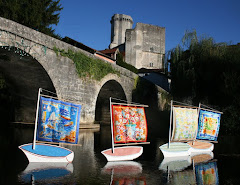Wednesday, February 22, 2017
Handsomely Beautiful, Exceptionally Foolhardy
This is the tale of three handsomely beautiful and exceptionally foolhardy Frenchies. A trio that were to be the first kayakers to descend the Green and Colorado Rivers. 900 wild and wooly miles of water between Green River, Wyoming and Lee’s Ferry, Arizona.
It all started in 1938, when a young adventurer, Bernard de Colmont, returning from Central America to France, fell in love with the southwest of the United States. As soon as he saw the waters of the mighty Colorado and her majestic canyon he wanted to experience and conquer that wildness. Crossing the Atlantic by steamship gave him plenty of time to think through how the project might be accomplished.
He figured that all previous descents had been made with traditional wooden river rafts that inevitably shattered at some point on the monstrous rocks strewn in the raging river. He decided to try a different strategy. He would make the trip in kayaks, reasoning that their greater maneuverability would make it easier to avoid rocks. As soon as he arrived home he started construction of three kayaks with rounded hulls instead of the typical rectangular form of the day. He based his design on traditional Inuit kayaks he had seen on his travels. The idea was that the shape would be more agile and replacements and repairs could be made more easily. This proved true as at one point when Bernard’s kayak was damaged. He was able to repair it with found wood in the bottom of the canyon.
Bernard easily convinced his new bride, Geneviève de Colmont, to join him on this adventure. Now they just had to find a third member. A telegraph was sent to an affable, competent, hiking friend, Antoine de Seynes.
“I am organizing an expedition to Colorado, would you like to be the third member?”
Antoine had to get out an atlas to look up where Colorado was. With no hesitation he said, “Yes.” He was 28 years old, graduated from Agricultural School, running the family farm, and regretting giving up his dream of going into Oceanography.
The three spent just 15 days in training on the local Ariège River, which has rapids that ripple more than they roar. Then the threesome was off. Paris to Le Havre, Le Havre to New York where they bought a used Lincoln. They drove cross country arriving in Wyoming on November 4th. They asked for official permission to make the descent and were told they would have to leave a $10,000 deposit - the amount required for the inevitable rescue of these three crazy kids. Having spent all their money on travels and supplies they could not come up with this large sum. They set up camp along the Green River anyway and started to prepare in secret. Somehow a journalist got wind of their plans and published an article in the local paper. The day of their departure found the banks of the river crowded with onlookers. Some there to wave goodbye, some trying to dissuade these foolhardy foreigners, and some just there out of curiosity.
These young explorers were well equipped for the time. They had the latest in technical fabrics, helmets, water tight sacks that would also float, and Geneviève had a special water-resistant watch called a ‘powder case watch’. Most important of all were the kayaks, incredibly light, easy to take apart and covered in a waterproofed fabric shell.
The three novice kayakers were off. Sixty days and 900 miles down the Green River to the intersection of the Colorado. They had to stop here as winter had become too bitter. Along the way they filmed each step of the voyage, from preparation, to rest stops, evenings in camp, and a lot of the descent - all on 16 and 35 mm color film- a rare thing for that time. They also used 8 mm black and white film, took copious amounts of photos, and each kept a journal of the journey. Unfortunately, only Antoine’s journal is known to still exist.
Their expedition was an enormous success. There were articles in many magazines and Geneviève was even on the cover of Marie-Claire. The men gave several conferences on the project. But their the world slid into the Nazi invasion, occupation, and then recuperation. There were more important things to concentrate on. Bernard continued to write for outdoor activities and Antoine continued kayaking, exploring the rivers of France.
In 1944 Antoine was helping in the Resistance. Two young men passing through France wanted to make their way to the Allies in North Africa. Antoine gave them his kayak from the Colorado expedition. The young men were picked up by the Spanish. However, their daring crossing set an example for the Allied parachutist units. Antoine’s kayak is now displayed at the National Center of Commando Training.
Now you ask, how did this story get dug up 75 years later…?
Fifteen years ago a historian from the University of Salt Lake City contacted Antoine’s son asking for more information on the trio. The American, Ian McCluskey, had fallen under the spell of this story after discovering a historical marker on the Green River at the launching of his own descent. Ian and a crew came to visit Antoine’s son and were handed over photos, the journal, and Antoine’s 8 mm film. Along with Antoine’s childhood memories of his father’s tales.
Ian’s quest led to a full length film retracing the journey.
Check out this site for more information:
**My information comes from an article in the SudOuest Saturday Magazine. Some information was a bit vague and I may have misinterpreted a few things. Still it makes a good story and maybe you’ll find a way to see the movie to get the straight story. I’ve ordered it to watch when I’m home visiting family. Dad will love it after years of taking us canoeing on the not so wild rivers of Virginia. Maybe we’ll even get out some of his old films of our adventures - he still has the projector!
Subscribe to:
Posts (Atom)












